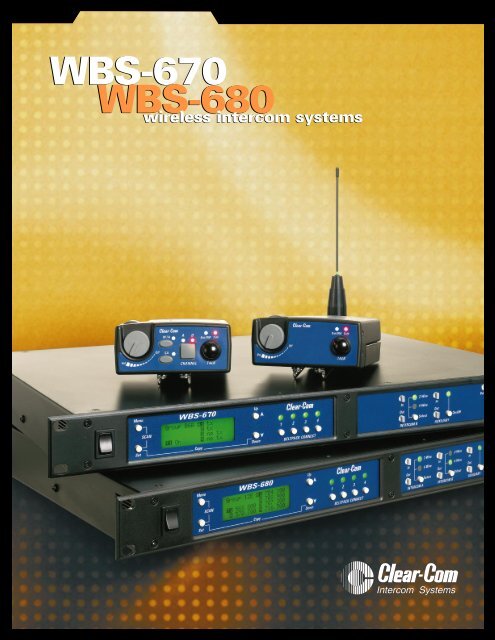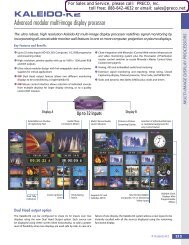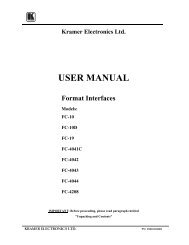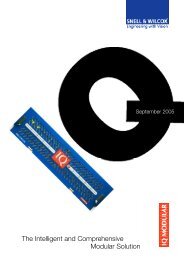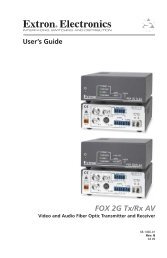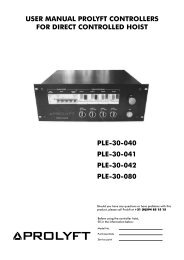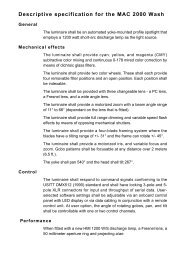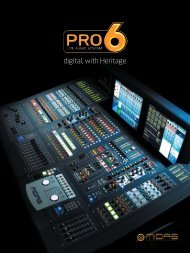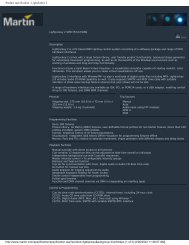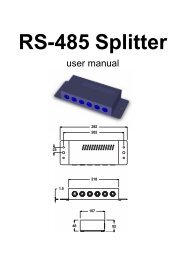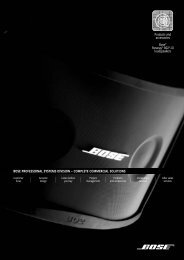WBS-670 WBS-680 WBS-670 WBS-680
WBS-670 WBS-680 WBS-670 WBS-680
WBS-670 WBS-680 WBS-670 WBS-680
You also want an ePaper? Increase the reach of your titles
YUMPU automatically turns print PDFs into web optimized ePapers that Google loves.
<strong>WBS</strong>-<strong>670</strong><br />
<strong>WBS</strong>-<strong>680</strong><br />
wireless intercom systems
<strong>WBS</strong>-<strong>670</strong><br />
<strong>WBS</strong>-<strong>680</strong><br />
frequency-agile UHF wireless intercom<br />
Whether you’re adding to a<br />
wired intercom system or<br />
creating a stand-alone<br />
wireless communications<br />
system, the <strong>WBS</strong>-<strong>670</strong> and<br />
<strong>WBS</strong>-<strong>680</strong> wireless intercoms<br />
are excellent choices.<br />
Combining frequency agility,<br />
audio clarity, powerful<br />
features, and roadworthiness<br />
with ease-of-use, these systems<br />
will extend the reach<br />
of your communications<br />
system in live theatre and<br />
performance, studio and<br />
mobile television production,<br />
industrial and aerospace<br />
applications, or wherever<br />
full-duplex wireless communications<br />
are required.<br />
<strong>WBS</strong>-<strong>670</strong> Single-Channel Wireless<br />
The <strong>WBS</strong>-<strong>670</strong> supports up to four full-duplex<br />
wireless beltpacks with its 1-RU base station.<br />
Multiple stations may be used together for<br />
larger productions, tied together via the partyline<br />
intercom channel. The WTR-<strong>670</strong> wireless<br />
beltpack features a low-profile on/off/volume<br />
control and a momentary/ latching talk button.<br />
Rugged detachable antennas are easily fieldreplaceable.<br />
The integral LCD window shows<br />
channel and frequency information, and<br />
allows the programming of beltpack channels<br />
and functions.<br />
The simple base-station front panel with its<br />
backlit LCD screen gives total control over<br />
frequency and beltpack selection, as well as<br />
control over the input and output level to an<br />
attached party-line or digital matrix intercom<br />
and an auxiliary in and out. If desired, a headphone<br />
may be connected to the front panel to<br />
communicate with the wireless beltpacks and<br />
the connected wired intercom system.<br />
The rear panel features 3-pin XLR loop-through<br />
connectors for one channel of party-line<br />
intercom, an RJ-45 connector for direct connection<br />
to a digital intercom port, and a pair of<br />
auxiliary connectors. Screw-on TNC connectors<br />
for the base station transmitter and receiver<br />
sections are fitted with a pair of efficient halfwave<br />
collinear antennas, or a variety of external<br />
antennas may be used. The <strong>WBS</strong>-<strong>670</strong> is<br />
compatible with virtually all wired party-line<br />
and matrix intercom systems.<br />
<strong>WBS</strong>-<strong>680</strong> Two-Channel Wireless<br />
Like the <strong>WBS</strong>-<strong>670</strong>, the <strong>WBS</strong>-<strong>680</strong> supports up<br />
to four beltpacks per base station. This system<br />
adds the ability to connect the wireless beltpacks,<br />
via the base station, to two channels<br />
of wired intercom — party-line, digital matrix,<br />
or one of each. A variety of different communications<br />
routings are activated from the beltpacks,<br />
with each beltpack user having full<br />
control; if desired, the technical director can<br />
lockout unnecessary functions on any individual<br />
beltpack.<br />
The WTR-<strong>680</strong> beltpack front panel provides a<br />
channel A/B selector button, allowing the user<br />
to talk and listen to either wired intercom<br />
channel A (plus the other wireless beltpack<br />
users on that channel) or wired intercom channel<br />
B. The WTR-682 beltpack allows the user<br />
to listen and talk on either or both of the two<br />
intercom channels. A “wireless talk around”<br />
button places the user’s voice on the wirelessonly<br />
bus, unheard by those on the wired intercoms.<br />
In addition, the beltpacks have a “stage<br />
announce” button, which when activated<br />
places the user’s voice off the intercom line
systems<br />
and onto an auxiliary output with associated<br />
relay on the base station — for paging and<br />
announcements.<br />
The <strong>WBS</strong>-<strong>680</strong> adds another wired intercom<br />
connector section on the rear panel, plus a<br />
stage-announce output and relay contact.<br />
Front-panel controls and indicators give control<br />
and status information about all of these communication<br />
connections. Also, a base-station<br />
link connector permits the “wireless talk<br />
around” to be shared among base stations.<br />
Frequency-Agile UHF Operation<br />
The <strong>WBS</strong>-<strong>670</strong> and <strong>WBS</strong>-<strong>680</strong> operate in selected<br />
frequency bands between 518 – 740 MHz.<br />
Three different sets are available for compatibility<br />
virtually anywhere. An 18 MHz (three U.S.<br />
TV channels) frequency window is used for the<br />
base-station transmitter, with a separate 18 MHz<br />
window for the beltpack transmit frequencies<br />
(base-station receive frequencies). These bands<br />
are each divided into 740 distinct frequencies<br />
at 25 kHz intervals. The <strong>WBS</strong>-<strong>680</strong> has two different<br />
base-station transmit frequencies —<br />
one each for intercom channels A and B.<br />
Adjustable Transmitter Power<br />
The base-station transmitter has a high-power<br />
setting of 100 mW (<strong>WBS</strong>-<strong>670</strong> is 50mW), a lowpower<br />
setting of 10 mW for closer distance<br />
use, and may be turned off when necessary<br />
for setup and linking. The beltpack transmitters<br />
have built-in sensing circuitry that drops the<br />
normal 50 mW output by 10 dB when close to<br />
the base station, to prevent de-sensing<br />
of its receivers.<br />
Pre-Selected Compatible<br />
Frequencies and Frequency Scan<br />
System setup is a snap using the 24 internal<br />
pre-selected and intermodulation-free frequency<br />
groups. Aided by the “scan” function, which<br />
senses the local RF environment and determines<br />
which of the frequency groups has the<br />
largest number of clear frequencies, base stations<br />
and beltpacks can typically be coordinated<br />
and working together within minutes.<br />
A dozen more memory locations are allocated<br />
for user-programmable groups, so that particular<br />
sets of frequencies can be chosen, programmed,<br />
and saved as a new preset.<br />
Great Audio Quality and Range<br />
Perhaps you’ve experienced that many of the<br />
available options for adding wireless capability<br />
to the intercom system end up sounding like a<br />
telephone or a two-way radio–intelligible but<br />
not great. The audio quality of the <strong>WBS</strong>-<strong>670</strong><br />
and <strong>WBS</strong>-<strong>680</strong> is on a par with that of a professional<br />
party-line or digital matrix intercom, so<br />
voice communications and program material<br />
sound more natural and less fatiguing. Efficient<br />
antennas and sensitive receiver design lead to<br />
excellent range for reliable use at a distance.<br />
A variety of remote antenna options, such as<br />
quarter-wave ground-plane and log-periodic,<br />
enhance that range and help with difficult<br />
production environments.<br />
Internal Audio Routing Options<br />
Circuit paths on the <strong>WBS</strong>-<strong>680</strong> main board may<br />
be wired, either internally or externally, to give<br />
variable-level dual-listen features to the beltpacks<br />
— one can hear channel A when talking<br />
on B, and vice-versa. This feature is set at the<br />
base station and affects all beltpacks identically.<br />
Also, base-station internal switching can<br />
place auxiliary audio on beltpack channel B<br />
only, or on both A and B.<br />
Rechargeable Battery Option<br />
The convenient battery pack will operate the<br />
beltpack in full-duplex mode for 14 hours<br />
with a set of alkaline batteries. The optional<br />
rechargeable NiMH (nickel metal hydride)<br />
batteries will give over 11 hours of continual<br />
use — enough to cover the entire production<br />
from setup to teardown. A 4-bay charger keeps<br />
a system’s worth of batteries at the ready.
<strong>WBS</strong>-<strong>670</strong> Rear Panel<br />
specifications<br />
<strong>WBS</strong>-<strong>680</strong> / <strong>WBS</strong>-<strong>670</strong> BASE STATION<br />
WTR-<strong>680</strong> / WTR-682/ WTR-<strong>670</strong> BELTPACKS<br />
Overall<br />
RF Frequency Range: 518-608 MHz, 614-740 MHz in 18 MHz TX and RX bands 518 - 608 MHz, 614 - 740 MHz in 18 MHz TX and RX bands<br />
<strong>WBS</strong>-<strong>670</strong> Only: 796-814 MHz Tx, Europe<br />
WTR-<strong>670</strong> Only: 844-862 MHz Tx, Europe<br />
Power Requirement: 100-240 VAC, 50-60 Hz, IEC receptacle 6 Alkaline "AA" Cells (NiMH optional)<br />
Typical Battery Life Alkaline: N/A 14 Hours (Continuous duty with talk light on)<br />
Typical Battery Life<br />
Nickel Metal Hydride (1500 mAh): N/A<br />
11 Hours (Continuous duty with talk light on)<br />
Current Draw: N/A 140 mA (Push-to-Talk, Talk On)<br />
Temp Range: -4 o F to 140 o F (20 o C to 55 o C) -4 o F to 140 o F (20 o C to 55 o C)<br />
Dimensions: 19.0" W x 1.72" H x 14.0" D (48.3 cm x 4.4 cm x 35.6 cm) 3.75" W x 5.05" H x 1.65" D (9.5 cm x 12.8 cm x 4.2 cm)<br />
Weight: <strong>WBS</strong>-<strong>680</strong>: 7 lbs. 2 oz. (3.24 kg) 16 oz. (0.454 kg) with alkaline batteries<br />
<strong>WBS</strong>-<strong>670</strong>: 6 lbs. 15 oz. (3.15 kg)<br />
15 oz. (0.425 kg) with alkaline batteries<br />
Transmit antenna: 1/2 Wave (supplied), TNC Male Connector 1/4 Wave (supplied), Screw type<br />
Receive antenna: 1/2 Wave (supplied), TNC Male Connector 1/4 Wave (supplied), Screw type<br />
FCC ID: B5DM514 B5DM515<br />
Frequency Response: 300 Hz - 8,000 Hz 300 Hz - 8,000 Hz<br />
Four-Wire Input: Level Adjustable (2 Vrms typical) N/A<br />
Four-Wire Output: Level Adjustable (2Vrms typical) N/A<br />
Clear-Com ® Intercom: Input/Output Level Adjustable (1 Vrms typical), Line Impedance 200 Ω N/A<br />
RTS ® Intercom: Input/Output Level Adjustable (0.775 Vrms typical), Line Impedance 200 Ω N/A<br />
Telex ® Intercom: Input/Output Level Adjustable (1 Vrms typical), Line Impedance 300 Ω N/A<br />
Auxiliary Input: Adjustable (2 Vrms typical) N/A<br />
Auliliary Output: Adjustable (2 Vrms typical into 600 Ω) (at rated deviation) N/A<br />
Stage Announce Output: Internally Adjustable (1Vrms typical at rated deviation into 100K Ω) N/A<br />
(<strong>WBS</strong>-<strong>680</strong> only)<br />
Stage Announce Relay: Dry contact, rated at 1Amp, 24 V Max. / N/A N/A<br />
(<strong>WBS</strong>-<strong>680</strong> only)<br />
Transmitter<br />
Type: Synthesized, 720 channels Synthesized, 720 channels<br />
Transmit Power: <strong>WBS</strong>-<strong>680</strong>: 100 mW max. (High), 10 mW (normal) WTR-<strong>680</strong> / WTR-<strong>670</strong>: 50 mW max.<br />
<strong>WBS</strong>-<strong>670</strong>: 50 mW max. (High), 5 mW (normal)<br />
(auto-power reduction when close to base)<br />
RF Frequency Stability: 0.005% 0.005%<br />
Modulation: FM, 40 KHz Deviation FM, 40 KHz Deviation<br />
Modulation Limiter: Peak-Responding Compressor Peak-Responding Compressor<br />
Modulation Frequency Range: 300 Hz -8,000 Hz + - 2 dB 300 Hz -8,000 Hz + - 2 dB<br />
Microphone Audio Input: 30 Ω - 3,500 Ω 30 Ω - 3,500 Ω<br />
Microphone Input Sensitivity: 9 mV 9 mV<br />
Radiated Harmonics & Spurious: Exceeds FCC specifications Exceeds FCC specifications<br />
FCC Acceptance: Type accepted under FCC Part 74 Type accepted under FCC Part 74<br />
Receiver<br />
Type: Dual Conversion Superheterodyne, Dual Conversion Superheterodyne,<br />
Synthesized, FM, 720 channels<br />
Synthesized, FM, 720 channels<br />
RF Sensitivity:


